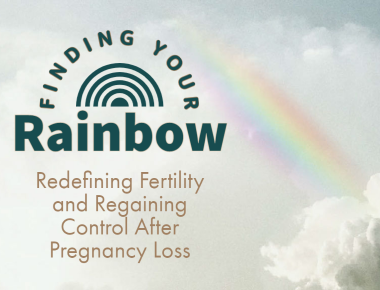Finding Your Rainbow

In the infertility community, a “rainbow baby” refers to a baby you have after experiencing infertility or pregnancy loss. It’s thought that the baby is your rainbow after the storms you’ve endured. This is a beautiful sentiment, and there are numerous stories of courage and resilience in which individuals share how they have endured significant physical, emotional, and, often, financial stress to finally have their rainbow baby.
While it is important to highlight these stories of hope that can follow pregnancy loss, it is just as important to emphasize that the path to your “rainbow” does not always need to include having a baby at the end. After someone has experienced miscarriage or infertility, there is often an assumption from loved ones, friends, and maybe even ourselves that we must try to have a baby again—and soon—whether that means trying to conceive again, utilizing assisted reproductive technology, or exploring other options, such as adoption.
After my miscarriages, I was often asked when my partner and I were going to try again and told “don’t give up” when we started to wonder whether we wanted to continue trying to have children. While these words of support were given with the best of intentions, they also assumed that there is only one “right” path after pregnancy loss: namely, to keep trying to have a baby. If this is the path you and your partner want to pursue, that is amazing. However, it’s important to take a moment to reflect and to consider what next step you want to choose for yourself.
The keyword here being—choose. Pregnancy loss has a way of taking away our ability to choose. It can feel like control or agency is taken away from you after a miscarriage. You experience a painful emotional and physical trauma without any say in the matter. Additionally, certain choices in your life, such as when to have a baby or how to have a baby, may become dependent on forces outside of your control, such as medical factors or even financial limitations. Consequently, pregnancy loss can leave individuals feeling disempowered and helpless. This exercise will support you in recognizing your agency after loss so you can find your own unique rainbow.
Click here to download the Find Your Rainbow exercise from The Miscarriage Map Workbook.
Learn more about helping couples work through a miscarriage in Dr. Osborn's next blog: Mourning Together, But Differently.
You can find more information on how to move forward from the trauma and grief surrounding pregnancy loss in The Miscarriage Map Workbook: An Honest Guide to Navigating Pregnancy Loss, Working Through the Pain, and Moving Forward.
*This is an adapted excerpt from The Miscarriage Map Workbook by Sunita Osborn, PsyD. Copyright © 2021, Sunita Osborn. PESI Publishing.
While it is important to highlight these stories of hope that can follow pregnancy loss, it is just as important to emphasize that the path to your “rainbow” does not always need to include having a baby at the end. After someone has experienced miscarriage or infertility, there is often an assumption from loved ones, friends, and maybe even ourselves that we must try to have a baby again—and soon—whether that means trying to conceive again, utilizing assisted reproductive technology, or exploring other options, such as adoption.
After my miscarriages, I was often asked when my partner and I were going to try again and told “don’t give up” when we started to wonder whether we wanted to continue trying to have children. While these words of support were given with the best of intentions, they also assumed that there is only one “right” path after pregnancy loss: namely, to keep trying to have a baby. If this is the path you and your partner want to pursue, that is amazing. However, it’s important to take a moment to reflect and to consider what next step you want to choose for yourself.
The keyword here being—choose. Pregnancy loss has a way of taking away our ability to choose. It can feel like control or agency is taken away from you after a miscarriage. You experience a painful emotional and physical trauma without any say in the matter. Additionally, certain choices in your life, such as when to have a baby or how to have a baby, may become dependent on forces outside of your control, such as medical factors or even financial limitations. Consequently, pregnancy loss can leave individuals feeling disempowered and helpless. This exercise will support you in recognizing your agency after loss so you can find your own unique rainbow.
Click here to download the Find Your Rainbow exercise from The Miscarriage Map Workbook.
Learn more about helping couples work through a miscarriage in Dr. Osborn's next blog: Mourning Together, But Differently.
You can find more information on how to move forward from the trauma and grief surrounding pregnancy loss in The Miscarriage Map Workbook: An Honest Guide to Navigating Pregnancy Loss, Working Through the Pain, and Moving Forward.
*This is an adapted excerpt from The Miscarriage Map Workbook by Sunita Osborn, PsyD. Copyright © 2021, Sunita Osborn. PESI Publishing.
Navigate Pregnancy Loss, Work Through the Pain, and Move Forward

After losing a pregnancy, many women feel alone in their trauma and grief. As clinicians, it's important to let them know that their feelings are valid and create a space for them to work through their emotions. In The Miscarriage Map Workbook, Dr. Osborn offers a straightforward roadmap to help women cope with pregnancy loss, allowing them to feel deeply understood, better equipped to handle life stressors, and more empowered to move forward in life.
Order your copy today: Get your copy today!
Order your copy today: Get your copy today!





